The Atlanta Child Murders refers to a cluster of thirty murders which took place within South-West Atlanta between July 1979 and May 1981. But to call them this is a misnomer as six of the victims were adults and the alleged serial killer, Wayne Williams, was never charged with killing any children.
The hit Netflix series Mindhunter grappled with this oddity in the final episode of what would be its final season, which covered the FBI's involvement in the case. In it was a brief reference to a little known alternative theory on these murders laid out in a book published not long after they took place called ‘The List’.
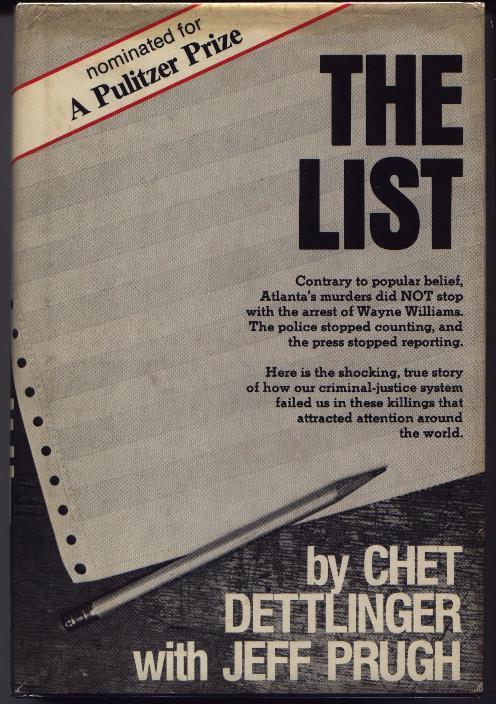
'The List' is a primary source of information written by an investigator named Chet Dettlinger with the help of a journalist named Jeff Prugh. In it is presented evidence to reasonably conclude the motive behind the majority of these murders had to do with a victims connection to child prostitution and pornography rings operating in Atlanta at the time. And that these connections had been known about by the task force in charge of the investigation, but were covered up by a powerful group of Atlanta politicians, whose motive for doing so was their affiliation with a youth program linked to a number of the victims.
As the official account goes, twenty-three children and seven adults were murdered by a twenty-three-year old child-talent scout named Wayne Williams. A closeted homosexual who achieved a sense of power and sexual gratification from the strangulation of young boys, and that this, his modus operandi, was the sole motive in these thirty otherwise random murders.
The nonsense of this is glaringly observed in the demographics of the victims themselves and their stated causes of death. Six victims had been men, not boys. Two victims girls, not boys. Some had died from blunt force trauma. One of a broken neck sustained from a fall. One had been shot. Another drowned. And one had been stabbed to death.
One victim who had in fact been murdered in accordance to the modus operandi developed for Wayne Williams, thirteen-year-old Clifford Jones who'd been raped then strangled to death, was murdered by someone other than Williams according to three eyewitnesses. Two had seen the victim's body being dumped behind a laundromat, while a third had actually seen the manager of that laundromat murder the boy just prior. All this was ignored on account of authorities labelling this witness 'retarded'.1 But a detective who worked that case maintained years later that this witness had been credible, and that the laundromat manager, Jamie Brooks, was still the most likely suspect not Wayne Williams.
Bob Sorkin reports on Clifford Jones murder, Channel 2 Action News, 1/6/1987
The death of one of the two adults Wayne Williams would be convicted of killing, twenty-one year old Jimmy Ray Payne, hadn’t actually been ruled a murder by the medical examiner until after Wayne Williams became a suspect, at which point their death certificate was subsequently altered.2
The official accounting of this case asks one to believe that a closeted homosexual with a penchant for strangling boys; shot, stabbed, bludgeoned, drowned, and pushed from great height, both male and female victims aged between seven and twenty-nine, in a series of serial child murders for which they were convicted of killing two adults. Even though this makes little sense, there is a logical explanation for framing the case in such a way.
The key assumption to this theory, or what you could call its thesis, is to treat each murder as a random motiveless crime by focusing attention away from details about the victims to details about their killer. Thereby reducing motive to the killer's psychological profile and the victims to demographics which fit it, even if they don't fit it. And even if they don't fit it as is the case here, since the profile is made up fiction it can be tweaked and modified to fit the facts as reality unfolds.
"The killer gets sexual gratification and a sense of control from strangling young boys. But also briefly experimented with killing young girls. Then the killer grew confident and graduated to killing adults."
With the right kind of credentials and hubris, confident bullshit can be mobilised to flesh out the parameters of an unrecognisable ‘pattern’. And there would be a motive for making these murders appear motiveless, if for instance, most of the victims fucking knew each other.
Running through the list of connections amongst the victims sends a chill down the spine and is perhaps the best way to demonstrate these murders were not what they seemed.
Victims one and two were Edward Hope Smith(14) and Alfred Evans(14), two friends who both attended Therrell High School that went missing in July 1979.3 Edward Hope Smith lived in an apartment next door to another boy from this school, Lee Manuel Gooch(15).4 Lee Gooch was not a victim but he would go missing at one point. The apartment Edward Smith lived in had been formerly occupied by victim nineteen, Terry Pue(15), who was also a friend of Lee Gooch.5 Remember that name, Lee Gooch.
The fourth victim was Yusef Bell(9) who disappeared in October 1979. Yusef Bell lived directly across the street from Lee Gooch’s grandmother's house, where Lee Gooch lived on and off. So Yusef Bell was also neighbours with Lee Gooch.6
The fifth victim to disappear was Jeffrey Mathis(10) in March 1980. His family lived around the corner from the West Hunter Street Baptist Church, where a friend of the family named Brandon Southern who’d known Jeffrey Mathis since he’d been an infant was the director of a juvenile rehabilitation program called The Challenge School for Boys, which was was linked to Lee Gooch and four other victims.7
The eighth victim Christopher Richardson(11), knew the ninth victim Latonya Wilson(7).8
The ninth victim LaTonya Wilson(7), had known and been neighbours with the twenty-ninth victim Nathaniel Cater(27).9
The tenth victim Aaron Wyche(10), had been friends and neighbours with the sixteenth victim Aaron Jackson(9)10, and the seventeenth victim Patrick Rogers(16).11
The eleventh victim Anthony Carter(9) had been neighbours with the twenty-third victim, Timothy Hill(13).12
The fourteenth victim Darren Glass(10) had known the twenty-seventh victim, Jimmy Ray Payne(21).13
The seventeenth victim Patrick Rogers(16) had known Lee Gooch14 and at least seventeen other victims.15
The twentieth victim Partick Baltazar(11) had known the twenty-third victim Timothy Hill(13),16 and the twenty-seventh victim Jimmy Ray Payne.17
The twenty-second victim Joseph Bell(15) was a friend and neighbour of the twenty-third victim Timothy Hill(13). Both had been members of the John Harland Boys Club along with the eleventh victim Anthony Carter(9).18 Joseph Bell had also known the twenty-sixth victim Michael McIntosh(23).19
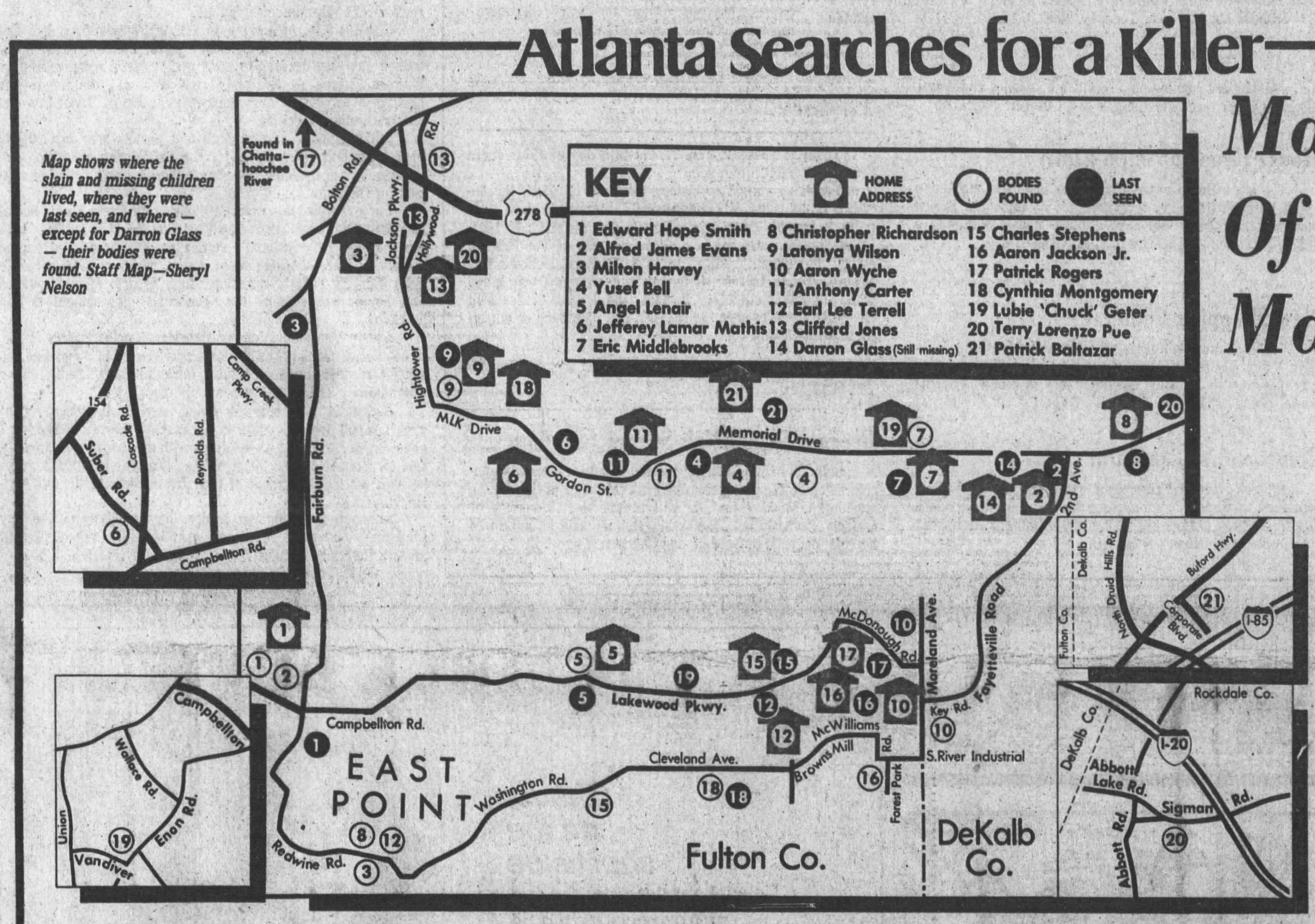
Map of Atlanta murder victims(as of February 1981) constructed by Chet Dettlinger found in his book The List and also published in the Atlanta Constitution February 17 1981.
These connections amongst the victims were reported in newspapers at the time and outlined by Chet Dettlinger in his book, The List. The book's theory of a motive in these murders is never stated outright, but can be read between the lines by the careful reader who assumes all the information presented is pertinent. Its 1983 publication made it prone to legal issues should the author have stated their conclusions plainly. But they came close with the following passage:
'' The spire of the West Hunter Street Baptist Church, another misnomer institution, loomed in front us. The church, pastored by Ralph David Abernathy, housed the headquarters of two organizations which would also figure prominently in the cases. One was the United Youth Adult Conference(UYAC), a social-service agency headed by then-City Councilman Arthur Langford Jr., and the other was the Challenge School for Boys, then directed by Brandon Southern.
One day I would stand in front of that church and comment to Peter Arnett(Pulitzer Prize-winner for his reporting on Vietnam) that this was a strange place in the murder cases— a place where victims would come out one door, searchers out of another and suspects out of both. ''
The final episode of what would be Mindhunter's final season features a title sequence unlike any other due to a slight alteration made to the shows title sequence. The piano keys of its theme were swapped out for the high-pitch vocals of a boys choir. And in the final minutes of that episode is the following scene:
This is a reference to the investigation into the eleventh victim Earl Lee Terrell(11). Earl Terrell disappeared in July 1980 and was last seen leaving a public swimming pool located across a road from where a white pedophile named John David Wilcoxen lived. A fifteen year old unidentified witness told investigators Earl Terrell had visited this man’s home on several occasions along with another boy. This other boy, another black teenager whose name was redacted from police reports, told police he would go to John Wilcoxen’s house to be paid for sex and photographs.20 He said Wilcoxen would pay him to bring younger boys to the house for this purpose, and that he and two others had taken Earl Terrell there on several occasions.21
The boy mentioned two associates of John Wilcoxen, Frank Hardy and Lionel St. Louis, the name of another boy involved with these men, a fourteen-year-old named Lubie Geter. Who would become victim number eighteen.22
These witness statements led to an investigation into John Wilcoxen and his two associates and the subsequent seizure of approximately 2000-4000 pornographic photographs of boys, as well as films showing the men engaged in sex with boys.23 Police described their discovery as, ”a child molestation ring of staggering proportions involving hundreds of children”.24 This is when the cover-up begun.
In March 1981 The Atlanta Constitution reported that the child sex ring had been uncovered during the course of the investigation into the missing Earl Terrell, though stated there was no connection between these pedophiles and the child slayings.25
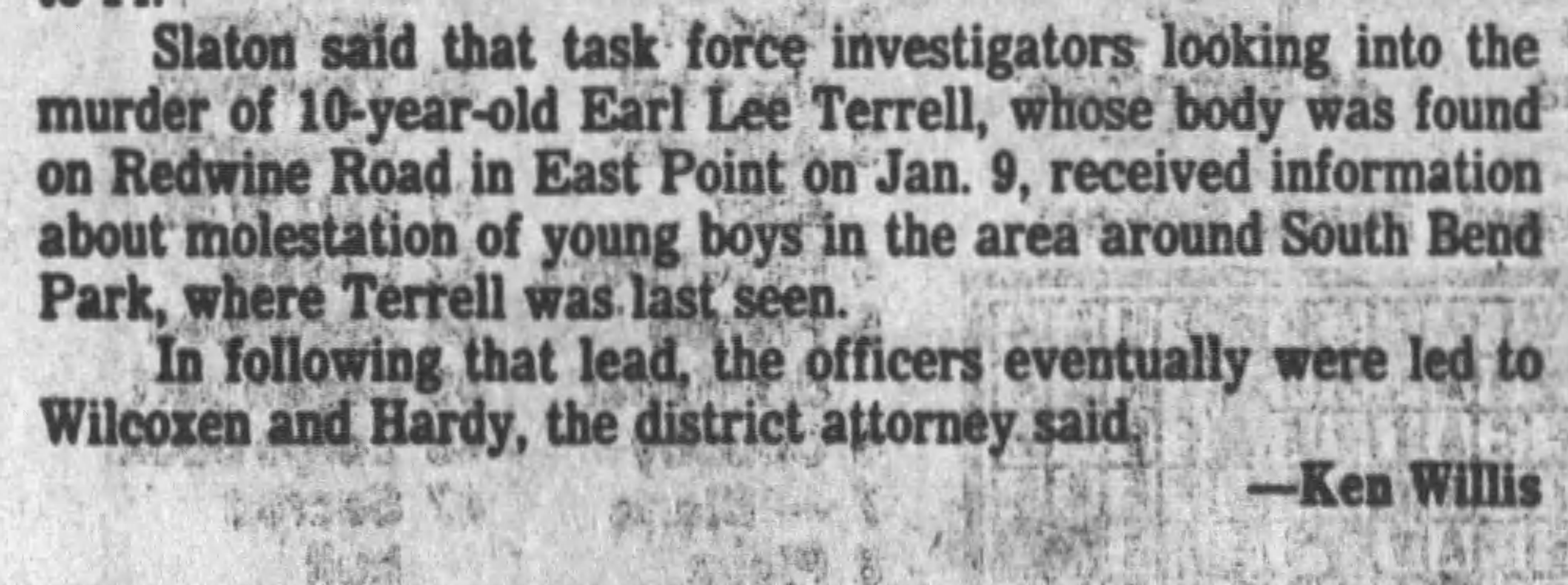
Atlanta Constitution, March 19 1981
However, the same newspaper then reported a month later in April the child sex ring had been stumbled across during a routine burglary investigation linked to a third man, Lionel St. Louis.26

Atlanta Constitution, April 16 1981
This was reiterated once more in May in a followup article which completely severed all association between the child sex ring and the child murders, stating only white boys had been used in the ring.27

Atlanta Constitution, May 21 1981
This was the official position of Atlanta PD in contradiction of their own internal reports, to which Chet Dettlinger had been privy. This was in spite of the fact a black teenager testified against John Wilcoxen at his trial.28
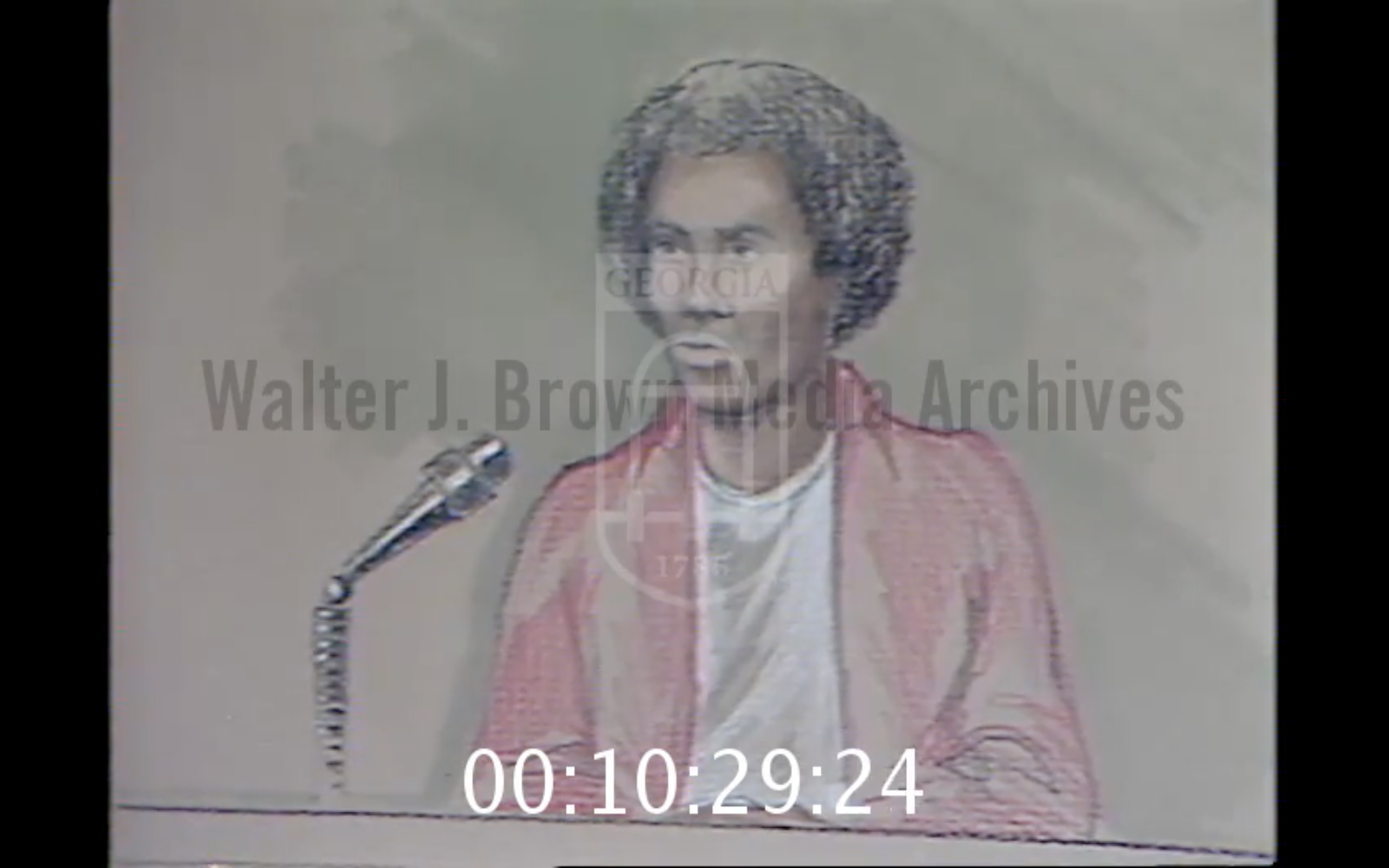
Courtroom sketch of witness who testified at John Wilcoxen's trial. Image was broadcasted on WSB-TV news coverage of the trial on 5/21/81.
Atlanta PD claimed only white boys had featured in the child pornography seized from John Wilcoxen and his associates, no black boys. However, a police recruit named Kenneth Lawson who had carried boxes of photographs seized from the homes of these pedophiles claimed there had been photos of black boys and these boxes had been delivered to the office of the commander of the task force formed to investigate the child murders, Morris Redding. Later, when those boxes were carried from his office all the photos of black boys had been removed.29 Morris Redding would later be promoted to Chief of Police by Mayor Andrew Young, who will figure into the case later.
The link between the Earl Terrell investigation and the child sex ring was clearly covered-up. Why it was covered up is less clear. Perhaps for a benign political reason to avoid stoking racial tensions at the time. Or—perhaps it had something to do with black boys used in the ring, such as Lubie Geter, also having something to do with Challenge School. A juvenile rehabilitation program housed at the historic West Hunter Street Baptist Church, an institution closely affiliated with a powerful group of politicians.
The Challenge School for Boys was a state funded alternative rehabilitation program for juvenile offenders directed by a man named Brandon Southern Jr.,30 that had around 35 offenders aged 12-16 enrolled via court order.31
Despite these limited enrolments, Challenge School can be directly linked to five of the victims, and through those five almost every other victim. It can also be directly linked to four witnesses who provided dubious, if not falsified statements that implicated Wayne Williams in their murders as well.
The first victim linked to Challenge School was 10 year-old Jeffrey Mathis who lived just around the corner from the West Hunter Street Baptist Church and had known the programs director Brandon Southern, who had been family friend for many years.32 Mathis was reported missing on March 11th 1980 after one of his classmates was him getting into a blue car with a man.33 This was not the last time he would be reported seen. A security guard named Willie Turner would tell police later that month he'd seen Jeffrey Mathis in a blue Nova with a white man out front of an adult bookstore on March 17th, not far from were he had been last spotted six days prior.34
Jeffrey Mathis' mother, Willie Mae Mathis, told Chet Dettlinger in 1980 that her daughter had been approached by a man driving a blue car in front of their home a few days after her son's disappearance. At that time Ms. Mathis indicated this man had been someone she’d known(not Wayne Williams).35 Later, during Wayne Williams trial she would tell the media the man in the blue car had been Wayne Williams, and that he’d driven by the house on the night of her son's disappearance, not three days after.36
The second Challenge School linked victim to go missing was 14 year-old Lubie Geter, the boy who had been named in the Earl Terrell/child sex ring investigation. Geter had been friends with boys enrolled at Challenge School and frequently visited them there at the West Hunter Street Church.37 Geter went missing on January 3rd 1981, the same month Atlanta PD claimed they'd stumbled upon the child sex ring during a routine burglary investigation.
Geter was last seen near a shopping center, where according to his older brother he, “made over $20 a day, hustling”.38
A Challenge School student named Daryl Davis told police he'd seen Geter get into a white Oldsmobile with a man unknown to him near the shopping center on January 2nd.39 Davis was called as a witness for the prosecution during Wayne Williams trial and testified that the man had in fact been Wayne Williams.40 In August 1980 this same Challenge School student had filed a police report stating he’d been abducted by two black males in a blue car.41 During the trial however Davis changed this to one black male, Wayne Williams, who he claimed had abducted him, fondled his genitals, but then let him go.42.
Two days after Lubie Geter disappeared his friend Lee Gooch went missing on January 5th. Lee Gooch had frequently visited Challenge School students at the West Hunter Street Church with Lubie Getter.
A few weeks later on January 21st the third Challenge School linked victim disappeared. A 14-year-old student of the program named Terry Pue who'd been a former next-door neighbour of the missing Lee Gooch.43
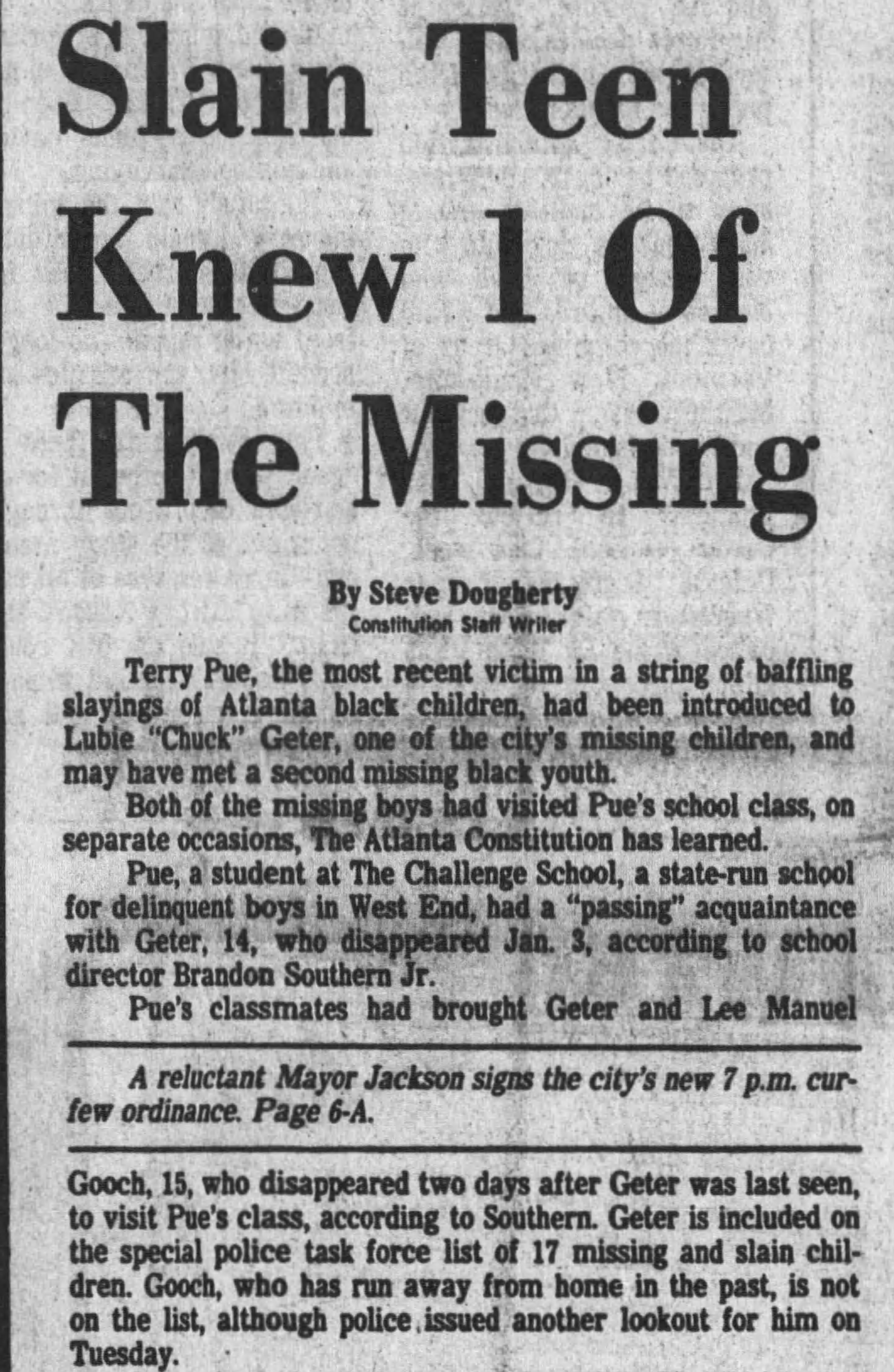
Atlanta Constitution, February 4 1981
The bodies of Lubie Geter and Terry Pue would be discovered later that month. Then in February Lee Gooch would be discovered too, in Florida very much alive. He’d been picked up on auto theft charges and was being held in a jail under another name. It had been Chet Dettlinger who tracked Gooch down during the course of his investigation.44 After he was discovered alive and well, Lee Gooch told press he'd seen three men try to kidnap a kid and knew a man in his neighbourhood who had "snatched some kids in December".45a 45b
Here was a boy claiming to have information on child abductions in his neighbourhood, who'd lived next-door to two of the murder victims - Edward Hope Smith and Terry Pue, across the street from a third victim - Yusef Bell, who had known at least three more victims - Alfred Evans, Lubie Geter, and Patrick Rogers, and who'd fled the state two days after one of those, his friend Lubie Geter who he'd visit Challenge School with, disappeared.
There is almost no record of Lee Gooch's connection to the case outside of a few news articles written when he was missing and thought to be a victim. He was never called to testify for either the defense or prosecution at Wayne Williams trial. But two boys he knew testified for the prosecution.
The aforementioned Challenge School student Daryl Davis, in addition to his two other testimonies that implicated Williams, also testified he’d seen Wayne Williams at Terry Pue’s funeral.46 This was corroborated by another Challenge School student named Eric Thompson, who had himself briefly disappeared in May 1981 and like Lee Gooch thought to have been a victim before he was tracked down and brought in by Challenge School director Brandon Southern.47 During the trial Chet Dettlinger tried to speak with Brandon Southern about the statements his students were making but learnt Southern had been recently fired as director, a position he'd held for over a decade, and was told Southern had gone into hiding.48
Channel 2 Action News report 5/7/1981
In March 1981 the fourth Challenge School linked victim dissappeared, a twenty-year-old named Larry Roger who was the older brother of a Challenge School student.49
Later that month the fifth Challenge School linked victim also disappeared, a former student of the program named Michael McIntosh(23), who was last seen by a local business owner looking severely beaten and crying, complaining he’d just been attacked by a group of blacks.50
Michael McIntosh had known another victim who would later disappear in May, Nathanial Cater(27). According to witnesses the two had worked in the same labor pool together,51 and hung around a gay bar called the Silver Dollar Lounge.52 Nathaniel Cater was one of the two adult victims Wayne Williams would be put on trial for killing. His body was pulled from the Chattahoochee River on May 24th, where Wayne Williams had been accused of dumping it in the early hours of May 22nd, when he’d been stopped by police after crossing one of its bridges around the time an officer had heard a splash.
After Williams had been charged with Nathaniel Cater’s murder and become a well-publicised suspect for the other killings, one of Nathaniel Cater’s neighbours, a woman named Margaret Carter, gave a television interview in August in which she claimed she’d seen Wayne Williams with Nathaniel Cater in a park near her apartment complex on May 25th.53 The day after Cater’s body had been pulled from the river.
That neighbour was the mother of a Challenge School student named Bobby Carter, who would testify as a witness for the prosecution at Wayne Williams trial.54 In her testimony she changed the date she’d spotted Williams and Cater together from May 25th, which was impossible, to May 22nd, still impossible according to the prosecutions contention that Williams had dumped Cater’s body in the river in the early hours of that morning.55
Five boys or young men directly linked to Challenge School were murdered: Jeffrey Mathis, Lubie Geter, Terry Pue, Michael McIntosh, and Larry Rogers.
Three witnesses directly linked to Challenge School modified statements which implicated Wayne Williams as a suspect: Willie Mae Mathis, Daryl Davis, and Margaret Carter. And forth corroborated one of their statements, Eric Thompson.
Lubie Geter, Terry Pue, and their friend Lee Gooch who had fled the state, all disappeared in January 1981. The same month Atlanta PD claim a routine burglary investigation led to the bust of a child sex ring, which we know had actually been uncovered during the course of an investigation into the missing Earl Lee Terrel via statements made by two unidentified witnesses. Statements which had named 14 year-old Lubie Geter as a boy being paid by the ring to procure younger boys, like 11 year-old Earl Terrell.
Two months after this in March two young adults linked to Challenge School disappeared as well. 23 year-old Michael McIntosh and 20 year-old Larry Rogers. These two older victims were involved with a different child sex ring also linked to some of the other younger victims.
Michael McIntosh knew a younger victim named Joseph Bell(15) who also disappeared in March.56 Joseph Bell was friends and neighbours with another victim named Timothy Hill(13) who went missing in March aswell. Both Joesph Bell and Timothy Hill were neighbours with a third victim some years younger than them named Anthony Carter(9), who’d gone missing much earlier in July 1980,57 the same month as the 11 year-old Earl Terrell. All three boys had been members of the John Harland Boys Club,58 where according to an employee Timothy Hill had been found having sex with another male. It is unclear if this had been a euphemistic way of stating “raped by another man”, which had been how Timothy Hill’s mother had put it in reference to an incident in Timothy's past.59
Timothy Hill was reported missing on March 13th, last seen by his younger sister getting into a taxi with a man who she said smeared a mud-like substance on Timothy’s face.60 A friend of Timothy Hill's told investigators the two of them would often visit a house at 522 Gray Street owned by a 63-year-old pedophile named Tom Terrell(no relation to victim Earl Terrell), where the boys would be paid for sex.61 The friend said one of these men, a 34-year-old security guard named Larry Marshall, had taken him and Timothy Hill to a Salvation Army store on March 9th with the intention of robbing it. The security guard had let Timothy inside but when he returned he was crying and said somebody had anally raped him.62
The security guard Larry Marshall had been employed by Wackenhut Corp,63 a security firm notoriously known as a CIA cutout involved in all sorts of sordid activities during the 1970s and 80s. He became the first real prime suspect before the investigation was focused on Wayne Williams. Marshall was arrested in Connecticut on March 20th at the request of Atlanta PD after having fled the state as he awaited trial on robbery charges.64
From jail Marshall told a reporter he’d actually fled Atlanta after a note was delivered to him by none other than victim Timothy Hill. This note he said, warned him to get out of Atlanta and was signed by “the Reverend E. C.”.65a 65b
The first ever reward fund setup for public information on the Atlanta Child Murders had been the Committee to Stop Children’s Murders(CSCM), started in conjunction with some mothers of the victims by a Reverend named Earl Carroll, or perhaps Reverend E. C., who claimed to be an assistant-pastor from the Wheat Street Baptist Church named Earl Carroll.66
The pastor of the Wheat Street Baptist Church Rev. William Borders denied this association.67 However, he'd chaired an event organised at the church by Earl Carroll, who'd spoke at the event and even introduced Atlanta’s chief of police to the pulpit.68
One of the mothers involved with Earl Carroll's CSCM had been Willie Mae Mathis, the same mother who had known Challenge School director Brandon Southern and claimed during Wayne Williams trial she her daughter had seen Wayne Williams drive by their home on the night of her son's disappearance. Only in the earlier version of that story she’d told Chet Dettlinger it’d been a different man, Reverend Earl Carroll.69 At one point Atlanta PD had considered him a suspect and placed a round the clock surveillance team on him. Earl Carroll had lived about a block away from the house at 522 Gray Street frequented by Larry Marshall and where Timothy Hill's friend said the boys were paid for sex.70
Larry Marshall had a pedophile roommate named Jerry Thornton(he was given the alias 'Frankie Mealing' in Chet Dettlinger's book) who had previously lived at 522 Gray Street with the pedophile Tom Terrell.71 That house had in fact been one of two owned by Tom Terrell on Gray Street. The other was a ramshackle house at 530 Gray Street that Jerry Thornton would tell investigators, and even the media, he'd seen at least 10 of the murder victims come in and out of at one time or another.72
ABC news, April 9 1981
A neighbour of Tom Terrell’s told investigators they’d often see Timothy Hill waiting for Terrell to arrive home on the front steps of the 522 Gray Street house and pointed out a large bucket on the property full of a mud-like chemical substance they said kids would sniff to get high. Matching the description of the substance Timothy Hill's sister had seen smeared on her brother's face when she last saw him get into a taxi with a man. Moreover, the neighbour stated Timothy Hill had stayed the night before he was reported missing at 522 Gray Street.73
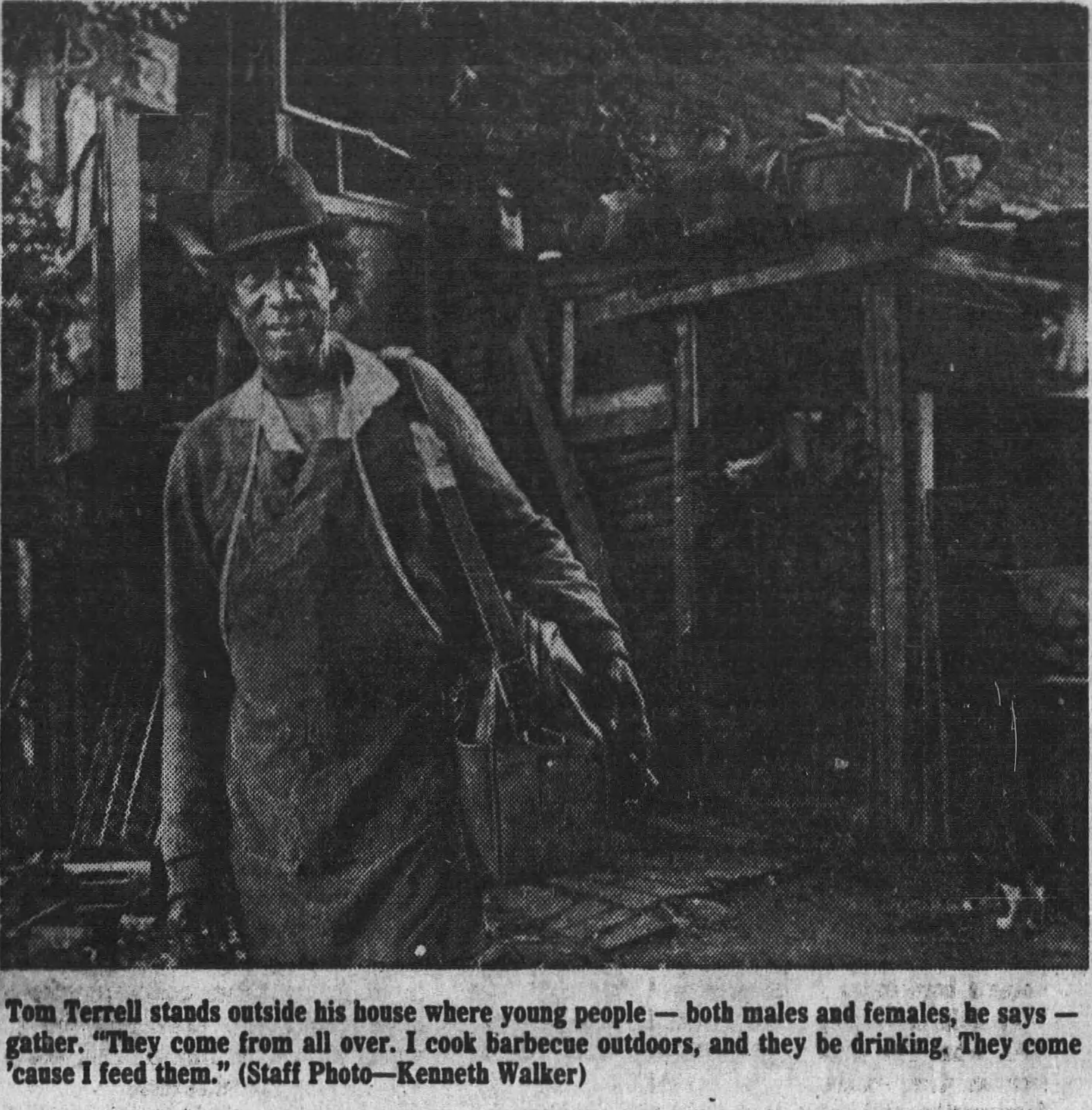
Police reports from the Timothy Hill investigation stated Larry Marshall's roommate Jerry Thornton had taken Timothy Hill to 530 Gray Street on March 11th and had anal sex with him, after which the two had walked over to 522 Gray Street and stayed the night with Tom Terrell.74 Tom Terrell admitted to having sex with Timothy Hill and confirmed the boy had slept at his house the night before his disappearance, and the last time he'd seen Timothy Hill was on the morning of the 12th.75a 75b Which was the last time anyone had seen him.
A friend of the twenty-second victim Joseph Bell identified Challenge School linked victim Larry Rogers as a frequent visitor to the Gray Street house along with Joseph Bell and Timothy Hill, and stated the last time they'd seen Joseph Bell had been at that house.76
The other older Challenge School linked victim Michael McIntosh worked with Joseph Bell at a fried chicken joint called Cap'n Peg's where the pair would often box together out the back.77 Like Larry Rogers, Michael McIntosh was also known to frequent the Gray Street house.78
Victims linked to the Challenge School for Boys were linked to two different child sex rings, both of which were linked to younger victims. These promising leads led to deadends, perhaps because of where Challenge School led. The West Hunter Street Baptist Church.
The West Hunter Street Church housed another youth program alongside Challenge School called the United Youth Adult Conference(UYAC), founded and directed by a young up and coming city councilman named Arthur Langford Jr.79
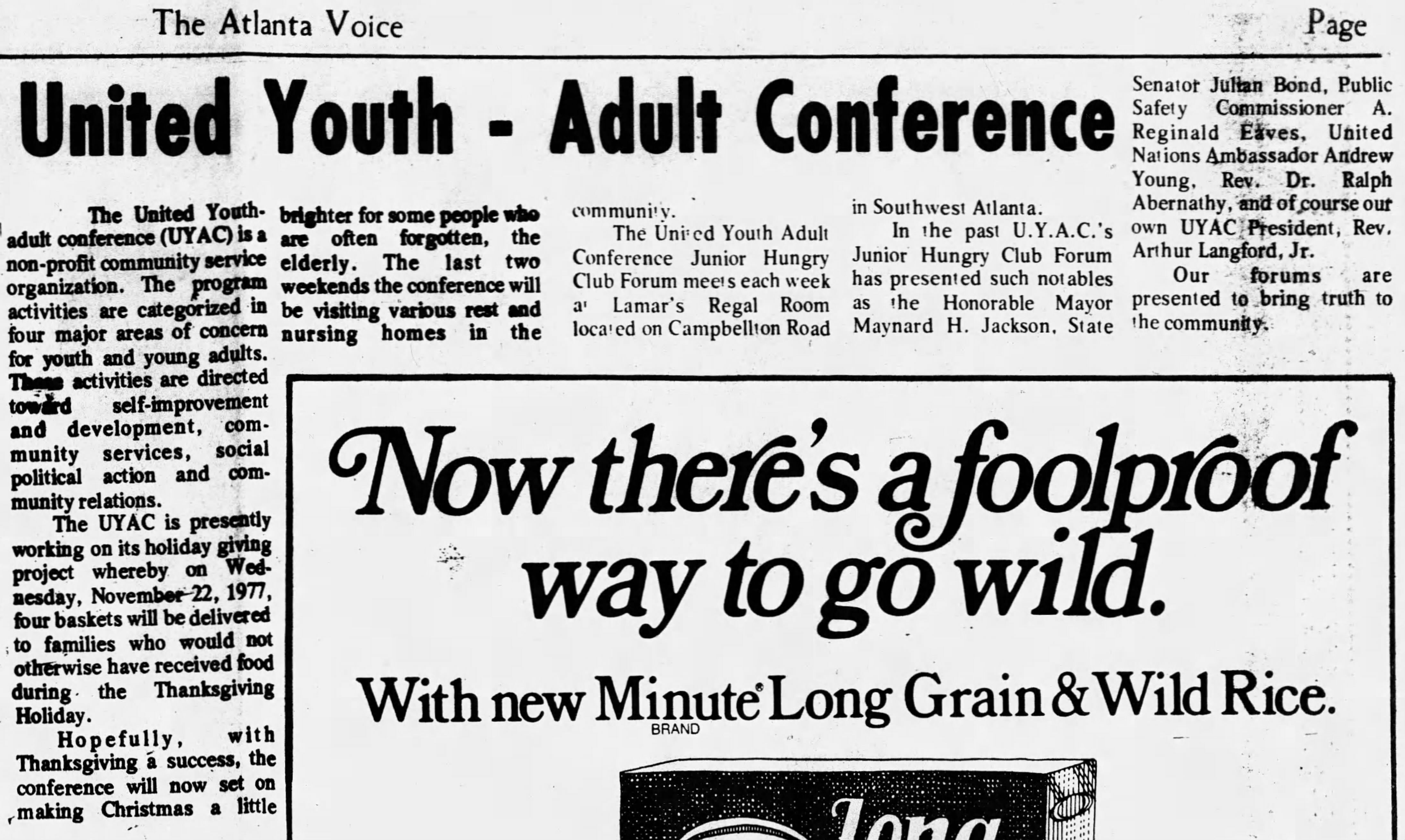
Atlanta Voice, November 26 1977
Langford's UYAC was affiliated with a close-knit group of politicians of which he had been apart, many of whom made political careers off the back of the civil rights movement and their association to the late Martin Luther King. Strangely, Arthur Langford and other members of this cadre had known Wayne Williams on a personal basis, who had himself been involved with youth programs of the UYAC.
Corine Brown, a youth council director in Arthur Langford’s district who testified at Wayne Williams trial, said Wayne had disk jockey'd UYAC sponsored events at youth dance halls and helped produce and audition children for talent shows sponsored by the UYAC. Corine Brown would state, “He(Williams) was very big with the kids. He directed the whole thing. The children seemed crazy about him”.80
When Wayne Williams was first publicly identified as a prime suspect Arthur Langford came to his defense, stating he’d known Wayne for four or five years and had been assured of his innocence.81
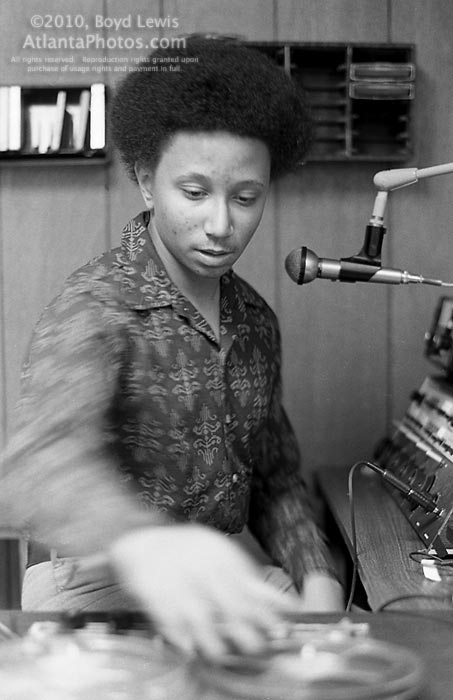
Wayne Williams' father, Homer Williams, had known Challenge School director Brandon Southern.82 In the summer of 1980 Homer Williams had visited a good friend of Southern’s, none other than Willie Mae Mathis the mother of Jeffrey Mathis who at that time had been missing for a number of months. According to Homer Williams he had sought Ms. Mathis support in attaining a police radio license for a colleague named James Comento who had also done freelance work with his son Wayne.83
Homer Williams had been a freelance photographer often hired to cover high-society functions held by Alanta's political elite.84 According to his testimony at his son's trial, Homer Williams had also photographed events held at the Kiwanis Club in downtown Atlanta,85 which had been a sponsor of the John Harland Boys club three of the victims belonged to.86 In a demonstration of his access, Homer Williams had been the only photographer allowed on stage at the Sammy Davis Jr., Frank Sinatra benefit concert held for the victims months before his son's arrest.
It was through his father Wayne Williams personally knew politicians affiliated with Arthur Langford and the UYAC.87 He knew Public Safety Commissioner A. Reginald Eaves, who'd hired him as a photographer on a number of occasions.88 He knew State congressman Hosea Williams(no relation), who'd hired him to work as an audio engineer on a radio show.89
Back in high school Wayne Williams had his own radio show he broadcasted from his parents house. Where he'd hosted and interviewed Mayor of Atlanta Sam Massell, congressman Tyrone Brooks,90 the President of the NAACP Benjamin Hooks,91 and most prominently future Mayor of Atlanta US congressman and one time US Ambassador to the United Nations, Andrew Young.
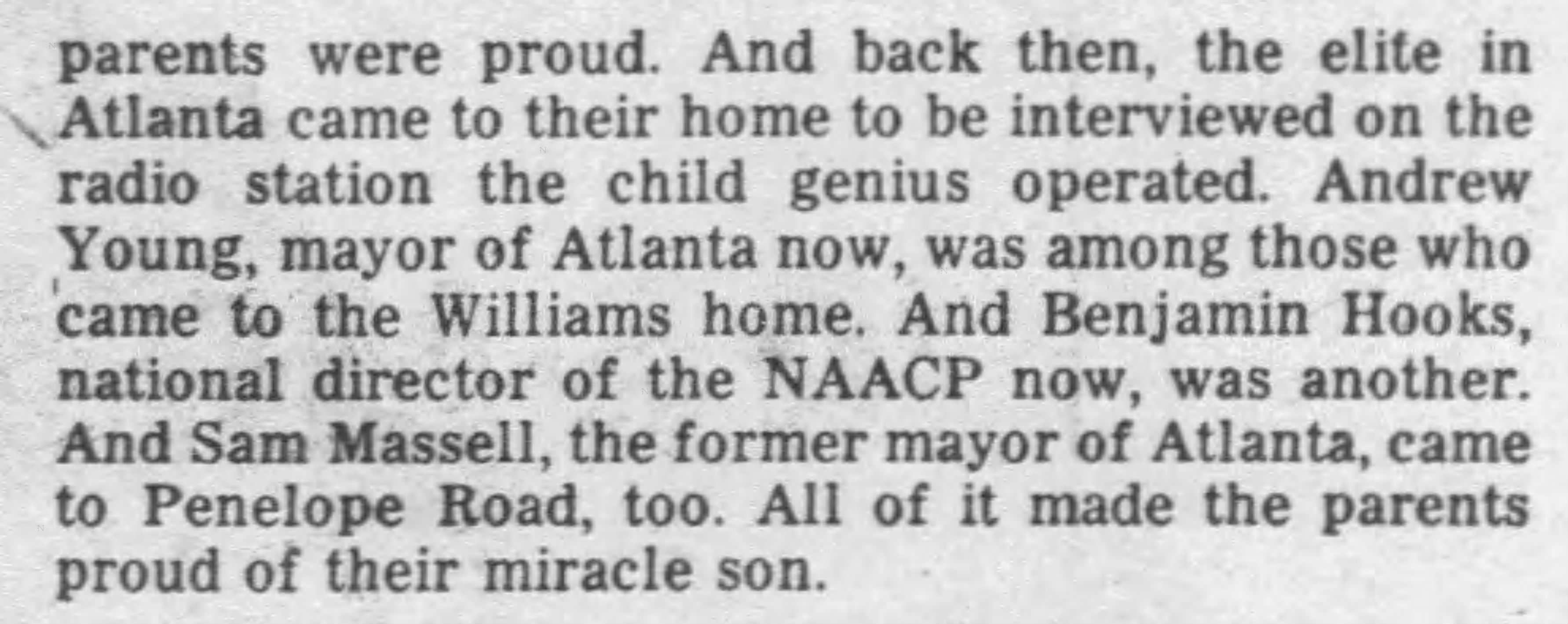
The Daily News, March 3 1982
Andrew Young had known Wayne especially well. He'd appointed him student council president of his High School when Wayne was in seventh grade, having commented "This is one of the brightest kids I’ve ever met".92
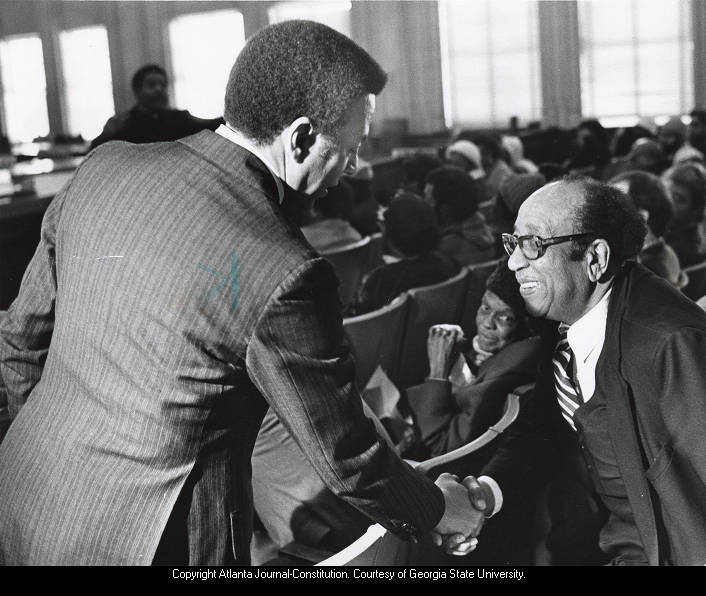
Mayor Andrew Young shakes hands with Homer Williams, father of Wayne Williams murder suspect, during a trial break at City Hall, 1982
Andrew Young left his position in Congress to serve as U.S Ambassador to the United Nations in 1977. He returned to Atlanta in the final months of 1981 to launch a successful Mayoral campaign which led to his inauguration as Mayor of Atlanta in the first week of January 1982. The very week Wayne Williams trial begun. As Mayor Andrew Young would promote Morris Redding to Chief of Police in Atlanta, the former task force commander who covered up the connection between the investigation into the victim Earl Terrell and the John Wilcoxen child sex ring.
A major campaign contributor to Andrew Young during his years in congress had been a well-known pornographer, and less-known child pornographer, named Michael Thevis. Thevis had been imprisoned in 1974 on a number of charges including transportation of obscene materials(child pornography) across state lines and the mail. There were no specific child pornography laws at that time only obscenity laws, which had inevitably led to the pornography controversy of the 1970s surrounding the arbitrary nature of obscenity. While it was true religious conservative groups sought to condemn homosexual pornography to this classification by conflating it with child pornography, it was also true progressive-minded groups sought to liberate child pornography from such classification by conflating it with homosexual pornography. To give clarity to the type of ‘obscene material’ Thevis trafficked in, court records give among the various titles of the porn he produced, “Boys and Their Male Lovers”, "My Boys”, and “Teenage Jaybirds”. 93a 93b
"A few of the publications featured photographs of nude males, frequently adolescent boys, sometimes displaying penile erections."
At a political fund‐raising luncheon in October 1976 Andrew Young told Micheal Thevis' wife, Joan Thevis, “I thought your husband got a bum rap.”.94
In 1977 it was revealed Thevis had funnelled $150,000 to Andrew Young in exchange for arranging a prison transfer to a federal medical facility. This was evidenced in a series of letters Young had written to the head of the Federal Bureau of Prisons, the last of which dated February 1977 had been on United Nations stationary.95a 95b 95c
Thevis later escaped prison upon being transferred out of that facility for a civil hearing in 1978, and was resourceful enough to arrange the murders of two former associates turned FBI informants in the witness protection program.96
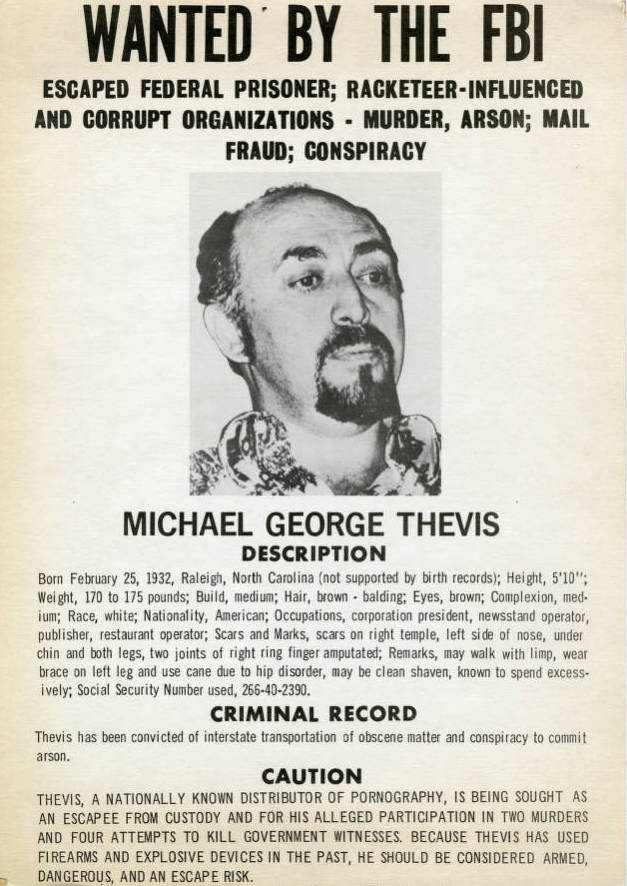
At the time Wayne Williams became a suspect in May 1981 he’d been ostensibly working as a talent scout taking kids off the street into recording studios. Two of these studios were owned by Michael Thevis - Apogee Records97 and Hotlanta Records. 98 In the case of Hotlanta Records, Williams hadn’t just taken kids there, he’d been paid to photograph them99 by the studio manager named Willie Hunter,100 described as a business associate of Williams.101 A boy who testified at Williams trial said he’d been paid to travel from South Carolina to Atlanta by bus to meet Williams, who had taken him to the Hotlanta studio and introduced him to Willie Hunter, who the boy said started a conversation with him about sex. The boy said when he’d been at Williams house he’d also been introduced to someone named ‘Nathanial’, perhaps alluding to Nathanial Cater, the adult victim whose murder Williams was on trial for.102
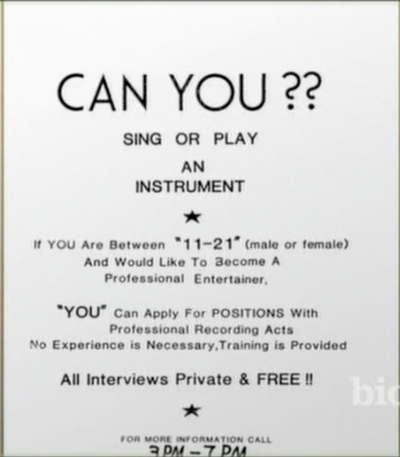
Wayne Williams scouting flyer.
Not long after Wayne Williams became a suspect on May 22nd 1981, electronic equipment and recordings were destroyed in acts of vandalism at the Apogee studio owned by Thevis, and another Williams had taken children.103a 103b
Williams had been pulled over in the early hours of that morning and was briefly questioned by police before he returned home to parent's house. No more than an hour or two later a neighbour witnessed Wayne and his father Homer burning photographs on a barbecue grill in their backyard.104 In the days that followed the two would burn more photographs in the backyard and jettison boxes of materials from their house.105
Skeptics allergic to deduction will never know what those photographs were of. But if we entertain the theory Wayne Williams and his father were involved in child pornography, perhaps that answers the question it begs. Why did they know so many politicians affiliated with the United Youth Adult Conference so well?
On June 4th 1981 Wayne Williams was publicly named as a prime suspect in the press. That same day he and his father were visited at their home by two UYAC affiliated congressmen, Hosea Williams and Tyrone Brooks. The stated purpose of this visit was to secure legal representation for Wayne Williams and offer him money in exchange for a confession. Chet Dettlinger interviewed the parties involved and they gave mixed accounts.
According to Hosea Williams he had told Wayne and Homer Williams that Mike Thevis’ attorney Ed Garland would take Wayne's case pro bono and said they would get $500,000 in reward money if Wayne confessed to the murders.106 Homer Williams said the sum offered for a confession was much higher, $4 million, and was told people in Washington could raise it.107
Tyrone Brooks said the visit had been to secure legal representation for Wayne, but said the issue was dropped the very next day when Wayne hired Mary Welcome as his attorney.108 Mary Welcome had worked for Ed Garland(Mike Thevis lawyer) before starting her own practise, and had herself previously represented Mike Thevis’ girlfriend and bookkeeper, Patricia McLean,109 who’d been accused of aiding Thevis in his escape from prison.110
Two weeks after this on June 19th a secret meeting was held at Governor George Busbee's mansion between local and federal law enforcement officials to discuss the status of the arrest warrant for Wayne Williams. Multiple sources at the meeting leaked to the press that Fulton County district attorney Lewis Slaton, who'd been apprehensive to authorise an arrest warrant for Williams due to lack of evidence, was pressured to do so by Governor Busbee.111a 111b Two days after this meeting the arrest warrant was authorised and Wayne Williams was perp walked out of his parents home in handcuffs on June 21st.
When the existence of the Governor's meeting first leaked to the press it was reported to have been arranged at the request of Vice-President George H. W. Bush,112 who had recently visited Atlanta as head of a White House task force formed in February to funnel $4.1 million in federal grants to youth programs in the Atlanta districts of Fulton and DeKalb where the victims were from.113
Some of that money trickled down into Arthur Langford’s UYAC program via a number of questionable allocations by the Fulton County Commission. In one instance $10,000 was allocated to the UYAC for a party.114a 114b These payments to the UYAC had come under scrutiny because two years prior in January 1979 UYAC director Arthur Langford had been indict on federal charges of extortion just after UYAC offices located at the West Hunter Street Church were broken into and donor lists stolen along with the typewriters used for the organisations mail correspondance.115
Langford had been under investigation by the FBI for using his position as a city councilman to extort money from fair organiser Donald Pavel in exchange for discounted licensing fees and permits required for the SouthWestern fair, held in September 1978.116
The money paid to Langford had been allegedly laundered through a UYAC jobs program that had employed thirty-five youths,117 the same number of juvenile offenders enrolled in Challenge School program,118 to work as trash collectors and ticket takers at the fairgrounds. Pavel had made payments to Arthur Langford’s brother and UYAC chairman Fred Williams, which Langford claimed had been distributed to the youths in the UYAC job program. That had been the story anyway, until Fred Williams was turned as an FBI informant and testified he’d acted as Langford’s bagman and delivered to Langford sums of up to $5000 from Donald Pavel for Langford's personal use. Fred Williams had worn a wire and recordings of Langford admitting as much were played to the court.119
Despite this evidence Langford’s attorney Tony Axam got him acquitted of all charges.120 Tony Axam would become Wayne Williams primary defense attorney alongside Mary Welcome.121
The interesting thing about the UYAC extortion scandal is it occurred in the early months of 1979, just before the first victims disappeared. And the 35 boys in the UYAC jobs program all became potential witnesses when it was claimed the payments received from Don Pavel had gone to them. And 35 was the number of students enrolled in the Challenge School program.
What we are left with are a series of questions the official accounting of the Atlanta Child Murders case cannot adequetly answer.
Why did so many of the victims know each other?
Why was the connection in the Earl Terrell investigation to Lubie Geter and the John Wilcoxen child sex ring covered up?
Why did Lee Gooch know so many of the victims and flee to Florida two days after his friend Lubie Geter went missing?
Why were Lee Gooch, Lubie Geter and four other victims all linked to Challenge School?
Why were Michael McIntosh and Larry Rogers, the two adult victims linked to Challenge School, also linked to the house on Gray Street being used as a child brothel?
Why did these two know two younger victims, Timothy Hill and Joseph Bell, who were also linked to the child brothel on Gray Street?
Why was the fact Timothy Hill was last seen at the house on Gray Street with men who admitted having sex with him ultimately ignored?
Why did multiple witnesses linked to Challenge School modify or makeup eyewitness accounts implicating Wayne Williams?
Why did Homer Williams know Challenge School director Brandon Southern?
Why was Brandon Southern fired as director of Challenge School not long before Wayne Williams trial and go into hiding?
Why was Wayne Williams involved with UYAC youth programs?
Why were donor lists and typewriters used for mail correspondance stolen from UYAC offices in early 1979?
Why did UYAC director Arthur Langford and other politicians affiliated with the program, such as Andrew Young, Hosea Williams, Tyrone Brooks, and Reginald Eaves, all know Wayne Williams and his father Homer Williams?
Why did the most prominent of these politicians, Andrew Young, know child pornographer Michael Thevis well enough to personally arrange a prison transfer for him?
Why did Wayne Williams take children to recording studios owned by Michael Thevis and photograph them?
Why were these studios broken into and equipment destroyed after Wayne Williams became a suspect?
Why did Wayne Williams and Homer Williams burn photographs in their backyard and remove boxes of materials from their home hours after Wayne Williams was first questioned by police?
Why did congressmen Hosea Williams and Tyrone Brooks visit Wayne Williams and his father on the day Wayne Williams was publicly identified as a prime suspect and offer him money in exchange for a confession?
Why was a secret meeting held at the Governor’s mansion to pressure the district attorney to arrest Wayne Williams?
Why was Wayne Williams, a man suspected of murdering children, arrested and convicted of murdering two adults?
Why did his conviction of murdering two adults put an end to the investigation into the murders of children?
Here's a theory.
The United Youth Adult Conference was being used as a front for the distribution of child pornography through the mail in exchange for donations. Which is why donor lists and typewriters used for mail correspondance were removed from UYAC's offices just prior to the extortion scandal in early 1979. Boys in the Challenge School program located in the same Church were being used to procure younger boys they knew to this end, which is why most of the victims knew each other. Wayne Williams was involved with UYAC youth programs because he himself was a child procurer. He fell into this role because his father Homer Williams was a child pornographer paid by politicians affiliated with the UYAC to cover their events. This is why Wayne and Homer Williams burnt photographs and removed boxes of materials from their home hours after Wayne first became a suspect. The motive for most of the murders was the victim's involvement in a child pornography or prostitution ring which could also be linked to a reputable organisations like the UYAC and affiliated individuals. First the youngest boys used by these rings were killed like Earl Terrell(11) and Anthony Carter(9) in July 1980. Then their older teenaged procurers were also killed like Lubie Geter and Terry Pue in January 1981, or Timothy Hill and Joseph Bell in March 1981. Next were the young adults involved and linked to these victims, such as Michael McIntosh(23) and Larry Rogers(20) in March 1981, then finally Jimmy Ray Payne(21) and Nathanial Cater(27) in April and May 1981. After these loose ends had been tied up a patsy was needed to end the investigation into these murders. Someone who could be plausibly linked to many of the victims, but who could also be trusted and controllable. Wayne Williams was chosen because of his role as procurer linked him to some of the victims, and the group of UYAC affiliated politicians knew him and his father well enough to control. This is why he was offered money in exchange for a confession and ended up with Tony Axam as his attorney, Arthur Langford's attorney in the UYAC extortion case. Through controlled opposition to the prosecution case against Williams, the murders could be framed in such a way as to implicate Wayne Williams, while at the same time insulate the connections to child prostitution, Challenge School, and the UYAC. Which is why the official accounting of the case makes no sense and why strong evidence connecting Wayne Williams to some of the victims was ignored for weaker evidence.
This theory raises some unanswered questions of its own, though not nearly as many as the official one. And since information regarding these murders was covered up, some things about them can't be known. . .because they were covered up. Thus any conjecture unfairly implicating those who used political pressure to this end, such as the aforementioned politicians affiliated with the UYAC, really only have themselves to blame.
| References |
|---|
Much of the information used in this article was found at cavdef.org, an excellent resource for the investigation into organised human sex trafficking rings. |
1. The List by Chet Dettlinger & Jeff Prugh, 1983 First Edition, page 48. |
2. Ibid, page 43. |
3. Ibid, page 53. |
5. The List by Chet Dettlinger & Jeff Prugh, 1983 First Edition, page 200. |
6. Ibid, page 220. |
7. Ibid, page 214. |
8. Ibid, page 187. |
9. Ibid, page 100. |
10. Ibid, page 164. |
11. Ibid, page 46. |
12. Ibid, page 248. |
13. Ibid, page 311. |
14. Ibid, page 53. |
15. Ibid, page 258. |
16. Ibid, page 249. |
17. Ibid, page 231. |
20. The List by Chet Dettlinger & Jeff Prugh, 1983 First Edition, page 79. |
21. Ibid, page 80. |
22. Ibid, page 80. |
23. Ibis, pahe 79-80. |
28. The List by Chet Dettlinger & Jeff Prugh, 1983 First Edition, page 314. |
29. Ibid, page 79. |
32. The List by Chet Dettlinger & Jeff Prugh, 1983 First Edition, page 214. |
33. Ibid, page 60. |
34. Ibid, page 211. |
35. Ibid, page 70. |
36. Ibid, page 453. |
37. Ibid, page 214. |
38. Ibid, page 210. |
39. Ibid, pages 426 & 505. Note: In the book Daryl Davis is referred to as "Witness X", a student at Challenge School. That Witness X was indeed a boy named Daryl Davis is confirmed on page 61 of file 23 in the public release of FBI files on the Atlanta Child Murders case. Atlanta_Child_Murders_Part_23_of_24.pdf |
40. Ibid, page 425. |
41. Ibid, page 198. |
42. Ibid, page 425. & Atlanta_Child_Murders_Part_23_of_24.pdf |
44. The List by Chet Dettlinger & Jeff Prugh, 1983 First Edition, page 222. |
45a. Ibid, page 215 |
46. Ibid, page 426. |
48. Ibid, page 426. |
50. Ibid, page 277. |
51. Ibid, page 330. |
52. Ibid, page 227. |
53. Ibid, page 332. |
55. Ibid, page 452. |
56. Ibid, page 277. |
57. Ibid, page 66. |
60. Ibid, page 248. |
61. Ibid, page 263. |
62. Ibid , page 264. |
64. Ibid, page 258. |
65b. Ibid, page 258. |
66. Ibid, page 71. |
67. Ibid, page 70. |
68. Ibid, page 74. |
69. Ibid, page 453. |
70. Ibid, page 261. |
71. Ibid, page 265. |
72. Ibid, page 261. |
73. Ibid, page 261. |
74. Ibid, page 265. |
75a. Atlanta Constitution, May 1 1981 75b. Ibid, page 264. |
76. Ibid, page 263. |
78. Ibid, page 296. |
79. Ibid, page 174. |
80. Ibid, pages 174, 342, 461. |
81. Ibid, page 341. |
82. Ibid, page 426. |
83. Ibid, page 225. |
85. Ibid, page 463. |
88. Ibid, page 459. |
89. Ibid, page 351. |
90. Ibid, page 466. |
91. Ibid, page 351. |
92. Ibid, page 8. |
93a. UNITED STATES of America v. Michael G. THEVIS and Peachtree News Company 93b. United States v. New Orleans Book Mart, Inc. - "A few of the publications featured photographs of nude males, frequently adolescent boys, sometimes displaying penile erections." |
96. UNITED STATES OF AMERICA, PLAINTIFF-APPELLEE, v. MICHAEL G. THEVIS |
97. Ibid, page 345. |
99. Ibid, page 317. |
101. Ibid, page 460. |
102. Ibid, page 443. |
103a. Atlanta Constitution, June 13 1981 103b. Ibid, page 345. |
104. Ibid, page 327. |
105. Ibid, page 326. |
106. Ibid, page 351. |
107. Ibid, page 352. |
108. Ibid, page 352. |
109. Ibid, page 340. |
110. NYTimes, May 15 1978 |